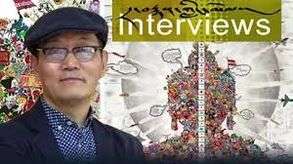Contemporary Tibetan art
Contemporary Tibetan art refers to the art of modern Tibet, or Tibet after 1950. It can also refer to art by the Tibetan diaspora, which is explicitly political and religious in nature. Contemporary Tibetan art includes modern thangka (religious scroll paintings) that resemble ancient thangka, as well as radical, avant-garde, works.
In the northeast of the Netherlands (Emmen), an Museum of Contemporary Tibetan Art has been established in 2017.[1]
Historical Tibetan art
For more than a thousand years, Tibetan artists have played a key role in the cultural life of Tibet. From designs for painted furniture to elaborate murals in religious buildings, their efforts have permeated virtually every facet of life on the Tibetan plateau. The vast majority of surviving artworks created before the mid-20th century are dedicated to the depiction of religious subjects, for the most part being distemper on cloth or murals. They were commissioned by religious establishments or by pious individuals for use within the practice of Tibetan Buddhism and were manufactured in large workshops by uncredited artists. These works not only document spiritual concepts but also demonstrate the vitality of Tibetan aesthetics over the centuries in terms of the cross-fertilisation of stylistic influences from other Chinese, Nepalese, and Indian styles.
After 1950
Historical Tibetan art followed a formal system of art making that was used to spread Tibetan religious culture. However, in 1950, the People's Republic of China gained sovereignty over Tibet while still granting autonomy to the area. This changed the social reality of life in Tibet, and modern Tibetan artists use their work as a mode of self-expression and exploration of their new, complex national identity.[2] Contemporary Tibetan artwork often conflicts with traditional artwork commissioned for religious purposes, and identity was largely tied to place, family lines, Tibetan language, and Tibetan Buddhism, with art serving as the transmission of the religion.[2] However, Tibetan art after 1950 raises questions of how globalization effects national and cultural identity, the conflict between tradition and modernity, and the influence of religion in a more secular age.[3]
Gonkar Gyatso

Gonkar Gyatso is a Tibetan-born British artist,[4] born in 1961 during the Cultural Revolution.[5] He studied thankga (scroll painting) in India before returning to Tibet in 1985, when he established the Sweet Tea House Contemporary Gallery, the first avant-garde artists association in Tibet.[4]
Gyatso's work incorporates pencils and stickers on paper using the technique of the Tibetan thankga.[5] He applies kitsch stickers to penciled images of the Buddha, and often adds commentary in speech bubbles.[5] These colorful children's stickers often take the form of characters from American movies and media, such as The Simpsons and Spiderman,[6] creating a cheap, consumerist appearance that contrasts with the meticulous and deliberate nature of their application.[5] These images draw the viewer's attention to the conflict between the meditative and spiritual aspects of Buddhism and worldly materialism.[5] Gyatso draws on his training in traditional art techniques to create work that explores Western consumer interests, the relationship between capitalism and culture, as well as the conflict between tradition and modernity, spirituality and materialism, and religion and secularism.[5]
Work of Gyatso is being exhibited at the Museum of Contemporary Tibetan Art in the Netherlands.[1]
References
- Braden, Laura; Oosterman, Naomi (2019). "World Systems Perspectives and Art: A Case Study of the Museum of Contemporary Tibetan Art in the Netherlands". Humboldt-Universität zu Berlin.
- Weingeist, Rachel Perera (2013). Anonymous: Contemporary Tibetan Art. Hong Kong: ArtAsiaPacific. p. 12.
- Gyatso, Nathalie (July 1, 2008). "Tibetan Art Today". Art Press. 347: 52–59 – via EBSCO Host.
- "Gonkar Gyatso".
- Martin-Chew, Louise (May 2012). "What you own ... Three Realms: Gonkar Gyatso, Brisbane". Art Monthly Australasia. 249: 14–17 – via EBSCO Host.
- "Exhibitions".